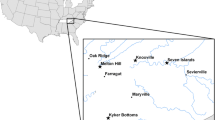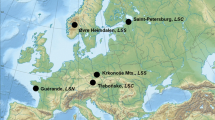Abstract
Antarctic organisms, including penguins, are susceptible to parasites and pathogens. Effects of infestation could differ in different locations along a geographical gradient from north to south consistent with conditions that affect the prevalence and virulence of parasites and pathogens. The immune system, including immunoglobulins as the main component of the humoral immune response, is the major way by which organisms confront infestation. We investigated the variation in immunoglobulin levels in three species of antarctic penguins (Pygoscelis antarctica, Pygoscelis papua, and Pygoscelis adeliae) along a geographical gradient from King George Island (62°15′S) to Avian Island (67°46′S). We found that immunoglobulin levels increased northwards in all the three species. This could indicate a higher impact of parasites and/or pathogens relative to the existing gradient in temperatures along this coast. Changing temperatures, consistent with global climate change, could be altering the ecology of parasite or pathogen infestation within the biota of northern Antarctica. We have also found marginal differences in immunoglobulin levels between sexes in both chinstrap and gentoo penguins.


Similar content being viewed by others
References
Barbosa A, Moreno E (2002) Sex differences in t-cell-mediated immune response in wintering great tits Parus major. Avian Sci 2:99–102
Barbosa A, Moreno E (2004) Cell-mediated immune response affects food intake but no body mass: an experiment with wintering great tits. Ecoscience 11:305–309
Bennett GF, Squires-Parsons D, Siikamäki P, Huhta E, Allander K, Hillström L (1995) A comparison of the blood parasites of three Fenno-Scandian populations of the pied flycatcher Ficedula hypoleuca. J Avian Biol 26:33–38
Blount JD, Metcalfe NB, Birkhead TR, Surai PF (2003) Carotenoid modulation of immune function and sexual attractiveness in zebra finches. Science 300:125–127
Boutette JB, Ramsay EC, Potgieter LND, Kania SA (2002) An improved polymerase chain reaction-restriction fragment length polymorphism assay for gender identification in birds. J Avian Med Surg 16:198–202
Chapell MA, Souza SL (1988) Thermoregulation, gas exchange, and ventilation in Adelie penguins (Pygoscelis adeliae). J Comp Physiol B 157:783–790
Clayton DH, Moore J (1997) Host–parasite evolution: general principles and avian models. Oxford University Press, Oxford
Dupas S, Boscaro R (1999) Geographic variation and evolution of immunosuppressive genes in a Drosophila parasitoid. Ecography 22:284–291
Ellegren H (1996) First gene on the avian W chromosome (CHD) provides a tag for universal sexing of non-ratite birds. Proc R Soc Lond B 263:1635–1641
Fellowes MDE, Godfray HCJ (2000) The evolutionary ecology of resistance to parasitoids by Drosophila. Heredity 84:1–8
Gardner H, Kerry K, Riddle M, Brouwer S, Gleeson L (1997) Poultry virus infection in Antarctic penguins. Nature 387:245
Gauthier-Clerc M, Eterradossi N, Toquin D, Guittet M, Kuntz G, Le Maho Y (2002) Serological survey of the king penguin, Aptenodytes patagonicus, in Crozet archipelago for antibodies to infectious bursal disease influenza A and Newcastle disease viruses. Polar Biol 25:316–319
Grasman KA (2002) Assessing immunological function in toxicological studies of avian wildlife. Integr Comp Biol 42:34–42
Grossman CJ (1984) Regulation of immune system by sex steroids. Endocr Rev 5:435–455
Gustaffson L, Nordling D, Andersson MS, Sheldon BC, Qvarstrom A (1994) Infectious diseases, reproductive effort and the cost of reproduction in birds. Phil Trans R Soc Lond B 346:323–331
Johnsen TS, Zuk M (1999) Parasites and tradeoffs in the immune response of female red jungle fowl. Oikos 86:487–492
Jones HI, Shellam GR (1999) The occurrence of blood-inhabiting protozoa in captive and free-living penguins. Polar Biol 21:5–10
Kerry K, Riddle M, Clarke K (1999) Diseases of Antarctic wildlife. A report for SCAR and COMNAP. SCAR
King JC, Turner J, Marshall GJ, Connolley WM, Lachlan-Cope TA (2003) Antarctic Peninsula climate variability and its causes as revealed by analysis of instrumental records. AGU Antarct Res Ser 79:17–30
Kraaijeveld AR, Godfray HCJ (1999) Geographic patterns in the evolution of resistance and virulence in Drosophila and its parasitoids. Am Nat 153:S61–S74
Lindgren E (1998) Climate change, tick-borne encephalitis and vaccination needs in Sweden—a prediction model. Ecol Modell 110:55–63
Lindgren E, Talleklint L, Polfeldt T (2000) Impact of climatic change on the northern latitude limit and population density of the disease-transmitting European tick Ixodes ricinus. Environ Health Perspect 108:119–123
Martínez J, Tomás G, Merino S, Arriero E, Moreno J (2003) Detection of serum immunoglobulins in wild birds by direct ELISA: a methodological study to validate the technique in different species using antichicken antibodies. Funct Ecol 17:700–706
McGraw KJ, Ardia DR (2005) Sex differences in carotenoid status and immune performance in zebra finches. Evol Ecol Res 7:251–262
Meloni S, Mazzini M, Buonocore F, Scapigliati G (2000) Humoral immunity in Antarctic fish: serum immunoglobulin analysis in seven species and antigen-induced response in Trematomus bernacchii (Teleostea, Notothenioidea). Ital J Zool 67:79–83
Merila J, Björklund M, Bennett GF (1995) Geographic and individual variation in haematozoan infections in the greenfinch, Carduelis chloris. Can J Zool 73:1798–1804
Merino S, Barbosa A, Moreno J, Potti J (1997) Absence of haematozoa in a wild chinstrap penguin Pygoscelis antarctica population. Polar Biol 18:227–228
Merino S, Martínez J, Møller AP, Sanabria L, de Lope F, Pérez J, Rodríguez-Caabeiro F (1999) Phytohaemagglutinin injection assay and physiological stress in nestling house martins. Anim Behav 58:219–222
Møller AP (1998) Evidence of larger impact of parasites on host in the tropics: investment in immune function within and outside tropics. Oikos 82:265–270
Møller AP (2002) North Atlantic Oscillation (NAO) effects of climate on the relative importance of first and second clutches in a migratory passerine birds. J Anim Ecol 71:201–210
Møller AP, Erritzoe J (1998) Host immune defence and migration in birds. Evol Ecol 12:945–953
Møller AP, Erritzoe J (2001) Dispersal, vaccination and regression of immune defence organs. Ecol Lett 4:484–490
Møller AP, Erritzoe J (2002) Coevolution of host immune defence and parasite-induced mortality: relative spleen size and mortality in altricial birds. Oikos 99:95–100
Møller AP, Erritzoe J (2003) Climate, body condition and spleen size in birds. Oecologia 442:621–626
Møller AP, Sorci G, Erritzoe J (1998) Sexual dimorphism in immune defense. Am Nat 152:605–619
Møller AP, Merino S, Brown CR, Robertson RJ (2001) Immune defense and host sociality: a comparative study or swallows and martins. Am Nat 158:136–145
Morales J, Moreno J, Merino S, Tomás G, Martínez J, Garamszegi LZ (2004) Associations between immune parameters, parasitism, and stress in breeding pied flycatcher (Ficedula hypoleuca) females. Can J Zool 82:1484–1492
Moreno J, de León A, Fargallo JA, Moreno E (1998) Breeding time, health and immune response in the chinstrap penguin Pygoscelis antarctica. Oecologia 115:312–319
Moreno J, Potti J, Yorio P, Garcia Borboroglu P (2001) Sex differences in cell-mediated immunity in the magellanic penguin Spheniscus magellanicus. Ann Zool Fenn 38:111–116
Nunn CL (2002) Spleen size, disease risk and sexual selection: a comparative study in primates. Evol Ecol Res 4:91–107
Nunn CL, Gittleman JL, Antonovics J (2000) Promiscuity and the primate immune system. Science Wash 290:1168–1170
Olson JJ (2002) Antarctica: a review of recent medical research. Trends Pharmacol Sci 23:487–490
Ots I, Horak P (1998) Health impact of blood parasites in breeding great tits. Oecologia 116:441–448
Ots I, Kerimov AB, Ivankina EV, Ilyina TA, Horak P (2001) Immune challenge affects basal metabolic activity in wintering great tits. Proc R Soc Lond B 268:1175–1181
Pastoret P, Gabriel P, Bazin H, Govaerts A (1998) Handbook of vertebrate immunology. Academic, San Diego
Potti J, Moreno J, Yorio P, Briones V, Garcia-Borboroglu P, Villar S, Ballesteros C (2002) Bacteria divert resources from growth for magellanic penguin chicks. Ecol Lett 5:709–714
Raberg L, Grahn M, Hasselquist D, Svensson E (1998) On the adaptive significance of stress-induced immunosuppression. Proc R Soc Lond B 265:1637–1641
Raberg L, Nilsson JA, Ilmonen P, Stjernman M, Hasselquist D (2000) The cost of an immune response: vaccination reduces parental effort. Ecol Lett 3:382–386
Redig PT, Lawler EM, Schwartz S, Dunnette JL, Stephenson B, Duke GE (1991) Effects of chronic exposure to sublethal concentrations of lead acetate on heme synthesis and immune function in red-tailed hawks. Arch Environ Contam Toxicol 21:72–77
Roitt I, Brostoff J, Male D (1996) Immunology. Mosby, London
Saino N, Martinelli R, Møller AP (2001) Immunoglobulin plasma concentration in relation to egg laying and mate ornamentation of female barn swallows (Hirundo rustica). J Evol Biol 14:95–109
Sladen WJL (1954) Penguin in the wild and in captivity. Avic Mag 60:132–142
Smits JE, Bortolotti GR, Tella JL (1999) Simplifying the phytohemagglutinin skin testing technique in studies of avian immunocompetence. Funct Ecol 13:567–572
Snoeijs T, Dauwe T, Pinxten R, Vandesande F, Eens M (2004) Heavy metal exposure affects the humoral immune response in a free-living small songbird, the Great Tit (Parus major). Arch Environ Contam Toxicol 46:399–404
Sol D, Jovani R, Torres J (2000) Geographical variation in blood parasites in feral pigeons: the role of vectors. Ecography 23:307–314
Sutherst RW (2001) The vulnerability of animal and human health to parasites under global change. Int J Parasitol 31:933–948
Szep T, Møller AP (1999) Cost of parasitism and host immune defence in the sand martin Riparia riparia: a role for parent–offspring conflict? Oecologia 119:9–15
Taylor JRE (1985) Ontogeny of thermoregulation and energy metabolism in pygoscelid penguin chicks. J Comp Physiol 155B:615–627
Tella JL, Scheuerlein A, Ricklefs RE (2002) Is cell mediated immunity related to the evolution of life-history strategies in birds? Proc R Soc Lond B 269:1059–1066
Terres G, Morrison SL, Habricht GS (1968) A quantitative difference in the immune response between male and female mice. Proc Soc Exp Biol Med 47:273
Turner J, Colwell SR, Marshall GJ, Lachlan-Cope TA, Carleton AM, Jones PD, Lagun V, Reid PA, Iagovkina S (2004) The SCAR READER project: toward a high-quality database of mean Antarctic meteorological observations. J Clim 17:2890–2898
Wakelin D, Apanius V (1997) Immune defence: genetic control. In: Clayton DH, Moore J (eds) Host–parasite evolution. General principles and avian models. Oxford University Press, Oxford, pp 30–58
Wikel SK (1996) The immunology of host-ectoparasitic arthropod relationships. CAB International, Wallingford, UK
Williams TD (1995) The penguins. Oxford University Press, Oxford
Acknowledgments
This study has been funded by the Acción Especial project REN2001-5004/ANT of the Spanish Ministry of Education and Science. The project CGL2004-01348/ANT supported AB while the paper was written. We very much appreciated the hospitality and logistic support of the Spanish Antarctic Bases “Juan Carlos I,” “Gabriel de Castilla” and the Spanish Polar Ship “Hesperides” and specially the Spanish Polar Ship “Las Palmas” which provided us the logistic support and transport to the localities. We thank Elena Arriero and Rafa Barrientos for laboratory assistance with molecular sexing. We also thank two anonymous referees for their comments that improved early versions of the manuscript.
Author information
Authors and Affiliations
Corresponding author
Rights and permissions
About this article
Cite this article
Barbosa, A., Merino, S., Benzal, J. et al. Geographic variation in the immunoglobulin levels in pygoscelid penguins. Polar Biol 30, 219–225 (2007). https://doi.org/10.1007/s00300-006-0175-9
Received:
Revised:
Accepted:
Published:
Issue Date:
DOI: https://doi.org/10.1007/s00300-006-0175-9




